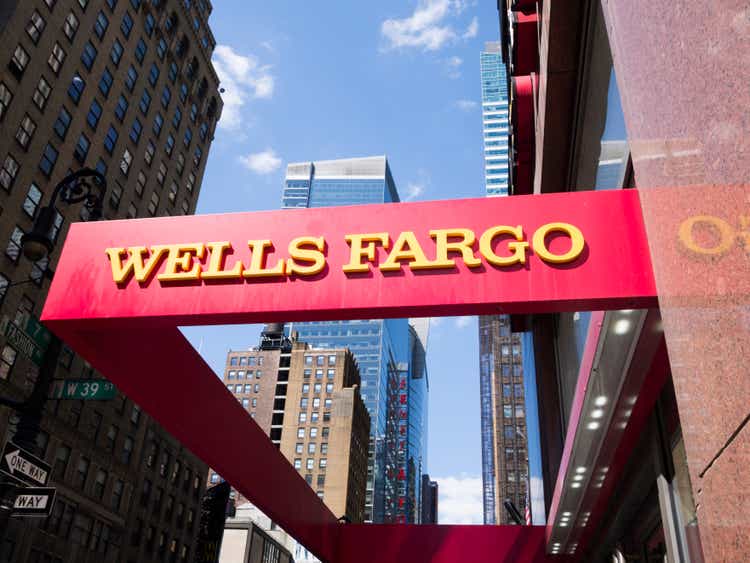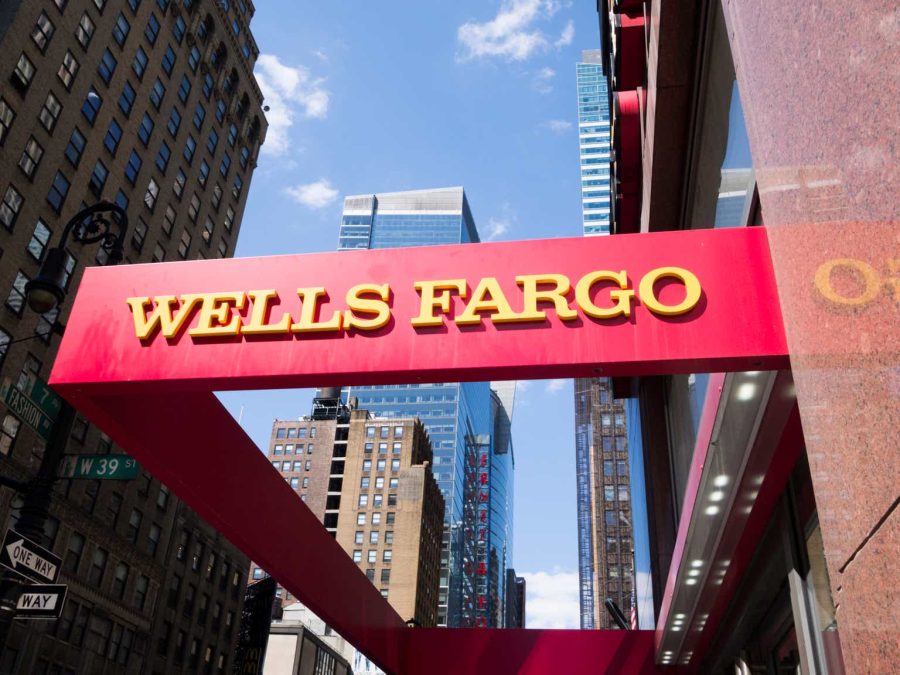Summary:
- Wells Fargo’s second quarter is likely to resemble recent quarters, with modest underperformance in lending (outside cards), healthy non-interest income, and rising credit costs.
- CRE credit is likely to get worse from here, but Wells Fargo is already well-reserved and this is likely to be a multiyear process.
- Wells Fargo continues to make progress on resolving outstanding regulatory and compliance issues, and the removal of the asset cap should unlock significant growth opportunities.
- Long-term core earnings growth in the neighborhood of 4% can support a fair value in the $60’s, as can ROTCE-driven P/TBV and P/E.
wdstock
Current operating conditions are still not exactly easy for Wells Fargo (NYSE:WFC), even excluding the self-inflicted headwinds of past management mistakes. An asset-sensitive bank, higher-for longer rates haven’t been all that bad for this bank. Wells Fargo’s strong core deposit franchise has allowed it to maintain a better-than-average deposit beta that has helped offset some weak lending performances that have, at least in part, been driven by the compromises needed to comply with the ongoing asset cap.
Wells Fargo shares are up more than 40% since my last update, performing not only the large bank group in general, but also close rivals like Bank of America (BAC) and JPMorgan (JPM). While I don’t see the same upside as before, I do think there is underappreciated leverage here on the other side of its regulatory remediation process, including opportunities in lending share growth, deposit share growth, trading growth, and middle market growth.
Not A Lot Is Likely To Change In The Very Short Term
Two of the last three quarters since my last update on Wells Fargo have seen modest pre-provision beats, and that’s basically what I’m expecting again this time around. Loan growth has been weak for large banks in general (basically flat in the second quarter), and I expect Wells Fargo to continue to underperform here. I’m also not that confident that rates will offer much leverage, and I see a modest risk of underperformance on net interest margin.
Where I do see the most potential for upside is in the fee income items. Investment advisory fees, trading revenue, and card fees have all been growing nicely, and I believe these can offer some upside again in Q2’24. I do see some risk to costs, though, as the bank continues to spend on remediation projects and invest in areas like capital markets growth.
I also do not expect any dramatic updates on the credit side. I’d be surprised if provisions weren’t meaningfully higher on a sequential basis, and likewise for net charge-offs. Management has been pretty active in reserving against its CRE office book (about 3% of loans, and around 11% reserved last quarter), and I don’t see conditions getting any better in major markets like San Francisco.
Management guided to a high single-digit year-over-year decline for net interest income in 2024 with the prior quarter, and I wouldn’t expect that to change much. It’s basically a “steady as she goes” situation, with most of the deviation in Q2’24 earnings likely to come from fee income, opex, and provisioning.
Meaningful Post-Cap Opportunities
I continue to be very interested in the leverage Wells Fargo could unlock once it exits this ongoing period of consent decrees and an asset cap that has meaningfully limited management’s options to grow the business over the last several years.
As a reminder, the company saw the OCC terminate a consent order in mid-February of this year, but eight still remain (three from the Fed, three from the OCC, and two from the CFPB). I don’t believe all of these consent orders will need to be ended before the asset cap could be removed, but I don’t expect any move on the asset cap until after the election this year, and the outcome of that election could well have some bearing on the regulatory/asset cap issue.
Eventually, though, the asset cap will be lifted, and Wells Fargo will be in a very different position where earnings growth opportunities are concerned.
First, while Wells Fargo is still a very small player in trading next to the likes of Bank of America, Citigroup (C), and JPMorgan (about one-quarter the revenue of the first two and 20% of the third), it has been growing the business nicely for some time now. I think it’s important to note that the asset cap has limited the capital that management can direct toward trading, and management has been syndicating loans to free up capital to reinvest here. Once the cap goes away, this could be an area of meaningful and profitable revenue growth, albeit with significant quarter-to-quarter and year-to-year volatility (it’s just the nature of trading).
I also see growth opportunities from regaining share in its core lending markets. Wells Fargo has been meaningfully undergrowing its rivals across both commercial and consumer lending, as the company has been restrained on marketing new products and devoting capital to lending growth. With a still-strong deposit base and cost advantages in funding, I believe Wells Fargo will look to regain that share, and I believe the bank could be particularly effective in middle-market lending in the second half of this decade.
Last and not least on the growth side, Wells Fargo is still relatively early in its efforts to expand its card lending. It’s still a small part of overall lending relative to Bank of America and JPMorgan (Citi is so reliant on card lending that it’s not a fair comp), but it’s growing and the bank’s recent offerings have proven quite competitive, leading to two straight quarters now where only Wells Fargo and JPMorgan delivered double-digit growth in their card loans.
Also significant, but not a revenue growth driver, is the opportunity for cost leverage as regulatory remediation efforts wind down. Between restrictions on growing the business (limiting leverage) and spending specifically to resolve outstanding regulatory/compliance issues, I believe there are at least a couple of points of operating leverage that can be unlocked by exiting the asset cap era, although it’s not obvious to me if Wells Fargo will immediately look to maximize leverage or will look to up its IT investments to support future growth.
The Outlook
The Fed’s recent stress test saw Wells Fargo with one of the highest capital requirement increases (a 90bps increase in the stress capital buffer to 3.8%), due in part to weaker non-interest income. I don’t see an ongoing problem here, though I do suppose this could limit some capital returns in the near term. I do note, though, that the bank is well-positioned for new liquidity rules and is in good shape for new capital requirements, particularly if recent rumors prove accurate and the actual capital increase for large banks is on the order of 5% (versus the initial proposal of 16%).
Wells Fargo came in about 7% ahead of my prior estimates for FY’23 (in terms of core earnings), and while I haven’t rolled all of that into new estimates, my FY’24 core earnings estimate is about 6% higher (the increases are more modest for FY’25/26). Using 2023 as the new starting point, I’m looking for around 3% growth over the next five years and about 50bp higher (4%) for the next 10 years.
Discounting those core earnings back, I believe Wells Fargo is undervalued below the mid-$60’s, and that’s still with an elevated discount rate over the next few years to reflect ongoing regulatory issues. Other valuation approaches (an ROTCE-driven P/TBV and 12-month P/E) give me similar values in the low-to-mid-$60’s.
To give some sense of what lifting the asset cap could do for valuation, Wells Fargo management is targeting a mid-teens ROTCE. They can’t get there with the asset cap in place, but I think it’s a valid target once the regulatory issues are resolved. If I valued Wells Fargo today on a 15% ROTCE, the fair value would increase to a little over $70, and importantly that’s still using today’s TBVPS (not giving the company credit for improved growth opportunities).
The Bottom Line
I wrote about PNC lately and the two banks offer roughly similar upside today, and while it’s easy to immediately conclude that they’re very different banks (PNC has a reputation for being conservatively-run and reliable), both have explicitly targeted growth in the coming years; Wells Fargo more from unleashing pent-up capabilities and PNC more from organic expansion into new markets.
In any case, I think there’s still an argument for owning Wells Fargo. There are near-term economic and credit risks, and mid-term risks around the regulatory situation, but sooner or later, Wells Fargo will be free to operate without the asset cap limitations. Once that happens, I believe the market may yet be surprised at the growth and returns the bank can produce, and the shares don’t fully reflect that potential.
Analyst’s Disclosure: I/we have a beneficial long position in the shares of JPM either through stock ownership, options, or other derivatives. I wrote this article myself, and it expresses my own opinions. I am not receiving compensation for it (other than from Seeking Alpha). I have no business relationship with any company whose stock is mentioned in this article.
Seeking Alpha’s Disclosure: Past performance is no guarantee of future results. No recommendation or advice is being given as to whether any investment is suitable for a particular investor. Any views or opinions expressed above may not reflect those of Seeking Alpha as a whole. Seeking Alpha is not a licensed securities dealer, broker or US investment adviser or investment bank. Our analysts are third party authors that include both professional investors and individual investors who may not be licensed or certified by any institute or regulatory body.
